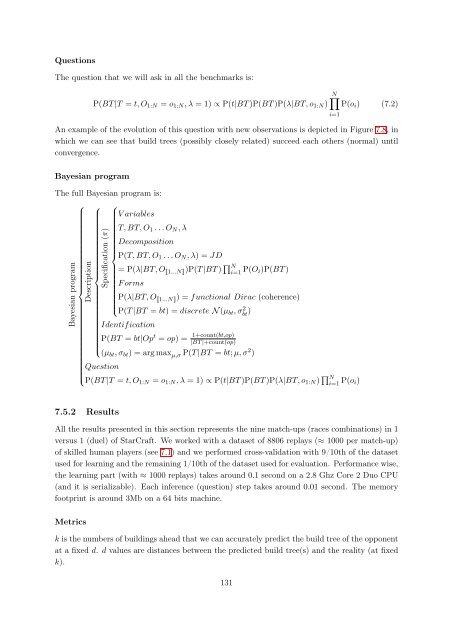Bayesian Programming and Learning for Multi-Player Video Games ...
Bayesian Programming and Learning for Multi-Player Video Games ...
Bayesian Programming and Learning for Multi-Player Video Games ...
Create successful ePaper yourself
Turn your PDF publications into a flip-book with our unique Google optimized e-Paper software.
Questions<br />
The question that we will ask in all the benchmarks is:<br />
P(BT |T = t, O1:N = o1:N, λ = 1) ∝ P(t|BT )P(BT )P(λ|BT, o1:N)<br />
N�<br />
P(oi) (7.2)<br />
An example of the evolution of this question with new observations is depicted in Figure 7.8, in<br />
which we can see that build trees (possibly closely related) succeed each others (normal) until<br />
convergence.<br />
<strong>Bayesian</strong> program<br />
The full <strong>Bayesian</strong> program is:<br />
⎧<br />
V ariables<br />
⎧⎪<br />
<strong>Bayesian</strong> program ⎨<br />
⎧⎪<br />
Description ⎨<br />
Specification (π)<br />
⎪⎩<br />
T, BT, O1 . . . ON, λ<br />
Decomposition<br />
⎪⎨ P(T, BT, O1 . . . ON, λ) = JD<br />
= P(λ|BT, O �1...N�)P(T |BT ) � N<br />
i=1 P(Oi)P(BT )<br />
F orms<br />
P(λ|BT, O�1...N�) = functional Dirac (coherence)<br />
⎪⎩<br />
P(T |BT = bt) = discrete N (µbt, σ 2 bt )<br />
Identification<br />
P(BT = bt|Opt = op) = 1+count(bt,op)<br />
|BT |+count(op)<br />
(µbt, σbt) = arg max µ,σ P(T |BT = bt; µ, σ2 )<br />
Question<br />
⎪⎩<br />
P(BT |T = t, O1:N = o1:N, λ = 1) ∝ P(t|BT )P(BT )P(λ|BT, o1:N) �N i=1 P(oi)<br />
7.5.2 Results<br />
All the results presented in this section represents the nine match-ups (races combinations) in 1<br />
versus 1 (duel) of StarCraft. We worked with a dataset of 8806 replays (≈ 1000 per match-up)<br />
of skilled human players (see 7.1) <strong>and</strong> we per<strong>for</strong>med cross-validation with 9/10th of the dataset<br />
used <strong>for</strong> learning <strong>and</strong> the remaining 1/10th of the dataset used <strong>for</strong> evaluation. Per<strong>for</strong>mance wise,<br />
the learning part (with ≈ 1000 replays) takes around 0.1 second on a 2.8 Ghz Core 2 Duo CPU<br />
(<strong>and</strong> it is serializable). Each inference (question) step takes around 0.01 second. The memory<br />
footprint is around 3Mb on a 64 bits machine.<br />
Metrics<br />
k is the numbers of buildings ahead that we can accurately predict the build tree of the opponent<br />
at a fixed d. d values are distances between the predicted build tree(s) <strong>and</strong> the reality (at fixed<br />
k).<br />
131<br />
i=1


